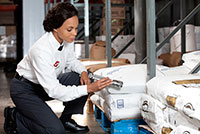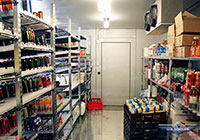Integrated Pest Management: Partnering to Improve Food Safety
By Brita Ball
A customer found a mouse in his food product. The mouse came from the processing plant. The pest control specialist had identified sanitation and structural deficiencies at the plant and documented them in his reports. Yet plant management had not ensured that corrective actions were taken. Whose fault was it, the food processor or the pest control company?
|
|
“Pest control specialists can only do so much to protect the food supply,” says Dr. Zia Siddiqi, Director of Quality Systems at Orkin. The truth is, food business operators have to take an active role in integrated pest management by working closely with the specialists.
“In the last few years, pest control has become more technically involved, with licencing and restrictions on chemicals,” Dr. Siddiqi says.
Tighter regulations for food safety, occupational health and safety, and the environment mean in-house pest control isn’t an option for many food businesses these days. And since pests behave differently even within a species, controlling them effectively requires special knowledge of the pests themselves, as well as ways to safely and efficiently manage them.
Pests in the Food Industry
“Cockroaches, rodents and flies are the main pest issues in food businesses,” says Dr. Siddiqi. An integrated pest management (IPM) plan has elements that are similar to a food safety management plan.
Other insects, and birds, can also be a food safety concern. Cockroaches and flies carry and transfer pathogens. Mice and rats spread Salmonella and other pathogens as they defecate and urinate during their travels. All of these pests can contribute general filth – a “yuck factor” – to food.
No matter what type of pest your operation needs to manage, having a pest management professional on your team is an effective way to reduce the risk of contamination to food. These specialists use an integrated approach to pest management.
The Integrated Pest Management (IPM) Approach
An integrated pest management (IPM) plan has elements that are similar to a food safety management plan. “It is a proactive approach to managing pests,” says Dr. Siddiqi, and “uses chemicals only as a last resort.
“IPM focuses on sanitation and property maintenance,” he says. It also includes sanitary design and staff training. These pest-prevention activities are similar to elements of pre-requisite programs.
Other elements of IPM are like the seven principles of HACCP:
- Analyze the pest hazards – Look at the facility and its location to determine what the potential “pest pressure” would be. An operation near a swamp or open fields will have different natural pressures than one in an industrial area in a large city.
- Identify critical areas where pests might enter and live – Consider incoming supplies and ingredients that could bring pests in; look for potential nesting areas or conditions conducive to attracting pests and/or allowing them to survive.
- Establish critical pest-limits – Determine the number of pests in an acceptable range. Maybe 5 meal moths are within a critical limit but 6 are too many.
- Monitor critical control points – Set appropriate traps and monitoring systems in the areas identified as key locations were pests are likely to be found.
- Establish corrective actions – Specify the actions to take when critical pest-limits are reached.
- Verify Effectiveness – Know which measures have been proven to safely and effectively manage the pests likely to be found in the facility.
- Keep Records – Document the integrated pest management plan, monitoring activities and corrective actions.
Pest Management Partnership
Food businesses can reduce food safety risk by establishing an effective pest-management partnership with their pest management professionals. This means taking an active role in integrated pest management.
When pest control was done in-house, all responsibility for success was with the food business. If outsourced, the food business must realize it has “an equal role to play in pest control” with the pest management professional, says Dr. Siddiqi.
The pest management professional can take whichever level of responsibility the facility needs. According to Dr. Siddiqi, this could include training employees to be on the lookout for pests.
Both parties must have a clear understanding of what each other is responsible for doing, he says.
About the Author
Brita Ball, PhD, CTDP, supports food businesses wanting to improve their culture of food safety and bottom line. She is a food safety specialist, principal consultant at Brita Ball & Associates, and Adjunct Professor at the University of Guelph. Brita is a regular contributor and an Industry Advisor to Global Food Safety Resource.
To have more articles like this emailed to your inbox, become a GFSR Member today!

-
 FeaturedRisk management
The Cost of a Breach: What a Cyberattack Could Mean for Food Safety Recalls
FeaturedRisk management
The Cost of a Breach: What a Cyberattack Could Mean for Food Safety Recalls
-
 FeaturedRisk management
Securing the Food Chain: How ISO/IEC 27001 Strengthens Cybersecurity
FeaturedRisk management
Securing the Food Chain: How ISO/IEC 27001 Strengthens Cybersecurity
-
 FeaturedRisk management
Revolutionizing Food Safety Training: Breaking Out of the “Check-the-Box” Mentality
FeaturedRisk management
Revolutionizing Food Safety Training: Breaking Out of the “Check-the-Box” Mentality
-
 GFSI Standards
GFSI 2025: Building Trust, Tech-Forward Solutions, and Global Unity in Food Safety
GFSI Standards
GFSI 2025: Building Trust, Tech-Forward Solutions, and Global Unity in Food Safety
-
 FeaturedFood Safety
Integrated Pest Management: Strategies to Protect Your Brand’s Reputation
FeaturedFood Safety
Integrated Pest Management: Strategies to Protect Your Brand’s Reputation
-
 FeaturedFood Safety Culture & Training
No Open Door Policy: Challenges That Impact Pest Control in Food Processing Plants
FeaturedFood Safety Culture & Training
No Open Door Policy: Challenges That Impact Pest Control in Food Processing Plants




